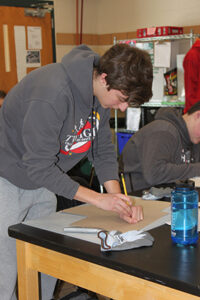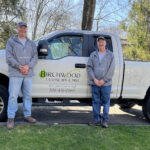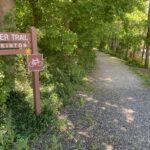
HHS junior Cody Ottinger works on a prototype of lighted gloves for an engineering challenge to identify a problem associated with a lack of light source. Students in Doug Scott’s engineering classes are taking part in Invention Education projects, which moves away from traditional project-based-learning to problem-solving learning in the classroom and community. PHOTO/MELISSA ORFF
Hopkinton High School students are working to solve real-world problems in their community — all from their own classrooms.
Engineering students at HHS are taking part in what is known as Invention Education, a process of learning that includes identifying a problem they care about and finding ways to solve that problem. In the five years that HHS engineering teacher Doug Scott has introduced Invention Education into his classroom, some creative solutions have emerged.
“As an engineering teacher I am always asking, What’s the problem?” said Scott, who also is Hopkinton Public School’s business/technology/engineering subject matter leader for Grades 6-12 and a robotics coach. “I want students to come up with solutions that are unique. … One student’s solution can be very different from another’s.”
The projects the students have worked on over the years weren’t just abstract, according to Scott. They were projects that would benefit themselves or others in their community. Last year, students worked with police and fire personnel to identify problems facing first responders and determine what current technologies exist to help them through patent research.
Projects ranged from developing a clip system to hang fire helmets in the truck to avoid having them fall off when in motion to developing a cooling system to help keep carcinogens from entering into the body through the skin of firefighters as they are exposed to fire and smoke. The student’s projects were highlighted in an article written by HHS student Emma McNamara and published in the January 2019 issue of TechDirections magazine.
“The idea of Invention Education is that the problems they are solving are applicable to life, as opposed to things that are abstract and not easily relatable to students,” Scott said. “Asking them to build a simple design that is given to them has its merits, but they don’t have the same connection to it as they do when they are identifying their own problems.”
This semester, students in Scott’s honors engineering class were given a challenge to identify a problem associated with a lack of light source. After they identified their problem, the budding engineers will brainstorm their solution, design a prototype of their solution, print a 3-D version of it and file a simulated patent application.
“They are learning what is involved with the patent process and how it’s important to protect your intellectual property,” Scott said.
Before they get to the patent process, however, the students have been hard at work identifying a solution to a problem that they are interested in solving.
“I run track and during the winter it gets really dark very early,” junior Cody Ottinger said. “I am designing gloves with lights on them to keep my hands warm, and they will light a path at night.”
Fellow junior Angie Grabmeier is working on a solution to a problem for handbag and backpack carriers.
“I am making a ring light that when you are looking into a bag for a hard-to-find item you will be able to see it clearly,” she said.
And whether the project ends up being a great solution to a problem or fails to make it past the prototype stage, the lesson learned is in the process of Invention Education.
“It allows the students to drive the learning,” Scott said. “It helps raise the level of thinking beyond simple projects.”






















0 Comments